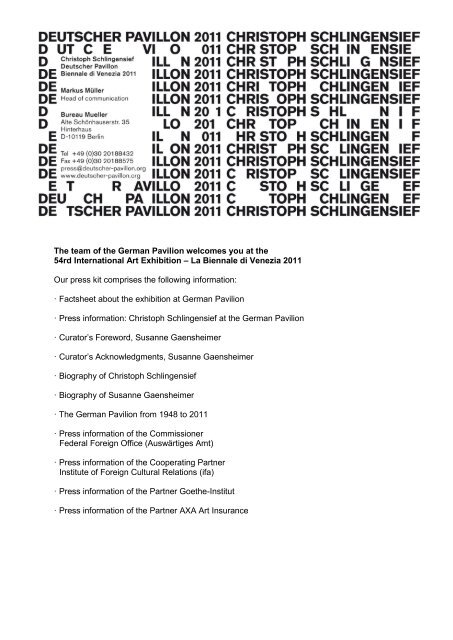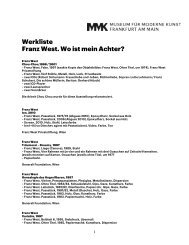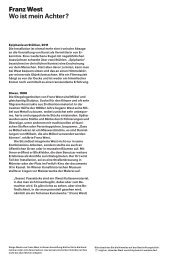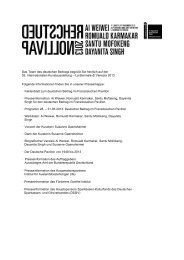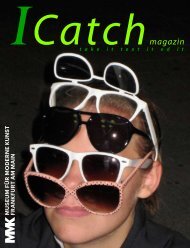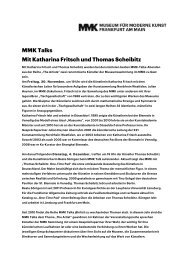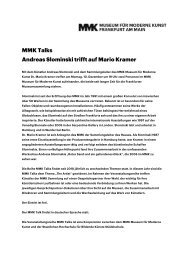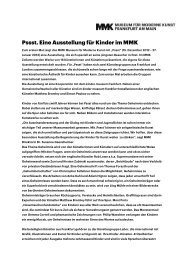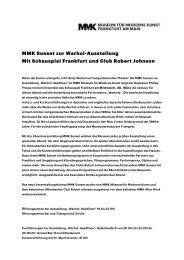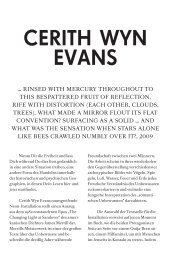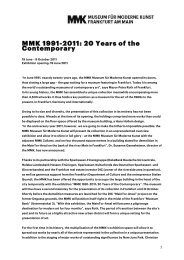Institut für Auslandsbeziehungen - Museum für Moderne Kunst
Institut für Auslandsbeziehungen - Museum für Moderne Kunst
Institut für Auslandsbeziehungen - Museum für Moderne Kunst
You also want an ePaper? Increase the reach of your titles
YUMPU automatically turns print PDFs into web optimized ePapers that Google loves.
The team of the German Pavilion welcomes you at the<br />
54rd International Art Exhibition – La Biennale di Venezia 2011<br />
Our press kit comprises the following information:<br />
· Factsheet about the exhibition at German Pavilion<br />
· Press information: Christoph Schlingensief at the German Pavilion<br />
· Curator‘s Foreword, Susanne Gaensheimer<br />
· Curator‘s Acknowledgments, Susanne Gaensheimer<br />
· Biography of Christoph Schlingensief<br />
· Biography of Susanne Gaensheimer<br />
· The German Pavilion from 1948 to 2011<br />
· Press information of the Commissioner<br />
Federal Foreign Office (Auswärtiges Amt)<br />
· Press information of the Cooperating Partner<br />
<strong>Institut</strong>e of Foreign Cultural Relations (ifa)<br />
· Press information of the Partner Goethe-<strong>Institut</strong><br />
· Press information of the Partner AXA Art Insurance
The German Pavilion<br />
54rd International Art Exhibition – La Biennale di Venezia 2011<br />
Duration: 4 June – 27 November 2011<br />
Press preview: 1 – 3 June 2011<br />
Press conference<br />
German Pavilion: 1 June 2011, 11 am, German Pavilion,<br />
Giardini della Biennale<br />
Opening of the<br />
German Pavilion: 1 June 2011, 2.30 pm, German Pavilion,<br />
Giardini della Biennale<br />
Official opening<br />
of the Biennale di Venezia: 4 June 2011, 10 am, Giardini della Biennale<br />
Director of the Bienniale: Bice Curiger<br />
Curator of the<br />
German Pavilion: Susanne Gaensheimer, Director of MMK <strong>Museum</strong> <strong>für</strong><br />
<strong>Moderne</strong> <strong>Kunst</strong>, Frankfurt am Main<br />
Artist at the<br />
German Pavilion: Christoph Schlingensief<br />
Exhibition title: Christoph Schlingensief<br />
Publication: Christoph Schlingensief<br />
Susanne Gaensheimer (ed.)<br />
The book presents texts by over thirty authors, including Diedrich<br />
Diederichsen, Charlotte Roche, Jonathan Meese, Alexander
Project Management<br />
for the German Pavilion: Christine Kaiser<br />
Editorial of the Publication<br />
and Assistant: Eva Huttenlauch<br />
Kluge, Carl Hegemann, Boris Groys, Hans-Ulrich Obrist, Matthias<br />
Lilienthal, Thomas Demand, among others.<br />
Published by Sternberg Press<br />
ISBN 978-1-934105-42-9<br />
Press Price: € (D) 20,00<br />
The German version will be published via Kiepenheuer & Witsch<br />
ISBN 978-3-462-04343-3<br />
Press Price: € (D) 20,00<br />
Press and Public Relations: Markus Müller, Bureau Mueller, Berlin<br />
Design: Double Standards, Berlin<br />
Commissioned by: Federal Foreign Office in collaboration with the<br />
<strong>Institut</strong>e of Foreign Cultural Relations (ifa)<br />
Partners: Goethe-<strong>Institut</strong>, MMK <strong>Museum</strong> <strong>für</strong> <strong>Moderne</strong> <strong>Kunst</strong><br />
Frankfurt am Main, Christoph Schlingensief estate, Courtesy<br />
Hauser & Wirth, Private sponsors, Friends of the <strong>Museum</strong><br />
Folkwang Essen, AXA Art Insurance, Bionade<br />
Lender: Ruhrtriennale, Hauser & Wirth, Thyssen-Bornemisza Art<br />
Contemporary<br />
Media partner: Deutsche Welle DW-TV<br />
Information: German Pavilion<br />
www.deutscher-pavillon.org<br />
La Biennale di Venezia
www.labiennale.org<br />
Contact: Eva Huttenlauch<br />
German Pavilion<br />
MMK <strong>Museum</strong> <strong>für</strong> <strong>Moderne</strong> <strong>Kunst</strong><br />
Domstraße 10<br />
60311 Frankfurt am Main<br />
Germany<br />
Tel +49 69 212 33953<br />
info@deutscher-pavillon.org<br />
Press contact: Markus Müller<br />
Bureau Mueller<br />
Alte Schönhauser Str. 35, Hinterhaus<br />
10119 Berlin<br />
Germany<br />
Tel +49 30 20188432<br />
presse@deutscher-pavillon.org
Press Information<br />
Christoph Schlingensief<br />
Christoph Schlingensief at the German Pavilion 2011<br />
Susanne Gaensheimer, Director of the MMK <strong>Museum</strong> <strong>für</strong> <strong>Moderne</strong> <strong>Kunst</strong> in Frankfurt and<br />
Curator of the German Pavilion at the 54th International Art Exhibition - La Biennale Venezia<br />
presents the pavilion.<br />
Elke aus dem Moore, Head of the Department of the Arts <strong>Institut</strong>e for Foreign Cultural<br />
Relations (ifa) and Aino Laberenz, Christoph Schlingensief‘s wife and longtime collaborator,<br />
complete the panel and are also available for your questions.<br />
The German Pavilion presents at the 54th International Art Exhibition - La Biennale di Venezia<br />
2011, an exhibition with works by Christoph Schlingensief.<br />
After Christoph Schlingensief`s death in late Summer of 2010, the curator Susanne<br />
Gaensheimer and Aino Laberenz, Christoph Schlingensief‘s wife and longtime collaborator,<br />
decided not to exhibit his latest project, which existed in developmental, sketch-like form, but<br />
rather, to show existing works in the Pavilion. In a constructive collaboration with a circle of<br />
close participants and confidants of Christoph Schlingensief including Carl Hegemann,<br />
Thomas Goerge, Voxi Bärenklau, Heta Multanen, and Frieder Schlaich, and drawing on<br />
extensive conversations with Chris Dercon, Alexander Kluge, Matthias Lilienthal, and Francis<br />
Kéré; Gaensheimer and Laberenz have developed a concept for the German Pavilion at the<br />
54th Venice Biennale. The selected works will provide a representative insight into his<br />
complex oeuvre and in particular cover the areas of theater, film, video, and Africa.<br />
In the main hall of the German Pavilion, the stage of the Fluxus oratorio A Church of Fear vs.<br />
the Alien Within has been installed, which Schlingensief conceived for the 2008 Ruhrtriennale.<br />
A Church of Fear vs. the Alien Within is perhaps Christoph Schlingensief‘s most personal<br />
work, where he portrays his illness openly and unsparingly, using his own painful experience<br />
to examine the existential circle of life, suffering, and death. The play‘s stage with its many film<br />
and video projections, and a multitude of spatial and pictorial elements, has the character of<br />
an encompassing spatial installation.
In the right wing of the pavilion‘s two side wings, a cinema will present a program of six<br />
selected films from different moments in Schlingensief‘s career are played on a large screen:<br />
Menu Total (1985–86), Egomania (1986), the Germany trilogy of 100 Jahre Adolph Hitler<br />
(1988), Das deutsche Kettensägenmassaker [The German Chainsaw Massacre, 1990], and<br />
Terror 2000 (1991–92), as well as his penultimate film, United Trash (1995–96). Presented on<br />
a structured schedule, these films exemplify central features of Schlingensief‘s filmic oeuvre.<br />
The theater is accessible at all times during the Biennale‘s opening hours and accomplishes<br />
two tasks at once, offering an international audience the opportunity to see a significant<br />
selection from Schlingensief‘s films—some of which have been subtitled for the first time—<br />
while introducing the artist‘s filmic visual language into the canon of visual culture.<br />
The pavilion‘s left wing is dedicated to Schlingensief‘s Operndorf Afrika, his opera village in<br />
Africa. Located near Ouagadougou, the capital of Burkina Faso, it includes a school which<br />
houses film and music classrooms, a café, a hospital, and a central theater building with a<br />
festival hall. The opera village is under the leadership of Aino Laberenz and planned with<br />
architect Francis Kéré. Alongside photographs and documentation of the already realized<br />
parts of the African project — and in conjunction with selected scenes from Via Intolleranza II,<br />
Schlingensief‘s last play in which he collaborated with actors from Burkina Faso — this portion<br />
of the pavilion will feature a large-scale panoramic projection of footage of the natural scenery<br />
surrounding the construction site of the opera village, filmed by an African filmmaker<br />
Schlingensief himself had commissioned for use in the German Pavilion.<br />
The publication of the German Pavilion in 2011 Christoph Schlingensief published by<br />
Sternberg Press, collects more than 30 contributions by authors such as Diedrich<br />
Diederichsen, Charlotte Roche, Jonathan Meese, Alexander Kluge, Carl Hegemann, Boris<br />
Groys, Hans-Ulrich Obrist, Matthias Lilienthal, Thomas Demand and many others.<br />
ISBN 978-1-934105-42-9, about 368 pages, soft cover, € (D) about 29.00<br />
Press Price: € (D) 20,00<br />
The German edition will be published by Kiepenheuer & Witsch.<br />
ISBN 978-3-462-04343-3, approx 368 pages, Hardcover, € (D) about 29.00<br />
Press Price: € (D) 20,00
We would also like to bring to your attention a discussion about Schlingensief‘s African Opera<br />
Village, presented by the Goethe <strong>Institut</strong>e, to be held in front of the side wing of the German<br />
Pavilion on June 2, 2011, at 4 PM (tbc). Aino Laberenz, Susanne Gaensheimer, Francis Kéré,<br />
Chris Dercon and Simon Njami are all expected to take part in this discussion.<br />
Moreover, we are extremely pleased to be able to announce that the <strong>Museum</strong> Folkwang in<br />
Essen has begun to plan a retrospective exhibition of Schlingensief‘s work and life, to take<br />
place as part of the 2012–2014 Ruhrtriennale (Artistic Director Heiner Goebbels).<br />
The exhibition for the German Pavilion for the 54 th Venice Biennale is sponsored by the<br />
Ministry of Foreign Affairs of Germany, and it was made possible with the partnership of the<br />
<strong>Institut</strong> <strong>für</strong> <strong>Auslandsbeziehungen</strong> (ifa). The pavilion is sponsored by the Goethe <strong>Institut</strong>e, Axa<br />
Art Insurance, by Friends of the <strong>Museum</strong> Folkwang of Essen and generous lenders and<br />
private supporters. Deutsche Welle DW-TV is our media-partner.<br />
Curator: Susanne Gaensheimer<br />
Artistic consulting: Aino Laberenz<br />
Dramaturgy: Carl Hegemann<br />
Stage design: Thomas Goerge<br />
Light Designer: Voxi Bärenklau<br />
Film editing and video: Heta Multanen<br />
Film programme: Filmgalerie 451 / Frieder Schlaich,<br />
Constantin Hartenstein<br />
Press and Communication: Bureau Mueller /<br />
Markus Müller, Ulrike Bretschneider, James Thomas<br />
Project Manager: Christine Kaiser<br />
Editorial Publication: Eva Huttenlauch<br />
Büro Schlingensief: Meike Fischer<br />
Technical Realisation: Ruhrtriennale / Joachim Janner, Harald Frings<br />
Architectural support: Clemens Kusch,
Martin Weigert<br />
Assistant Venice: Natasa Radovic<br />
Project coordination till December 2010:<br />
Eugenia Teixeira<br />
Commissioner: Auswärtiges Amt der Bundesrepublik<br />
Deutschland in collaboration with the <strong>Institut</strong>e of Foreign<br />
Cultural Relations (ifa)<br />
Partners: Goethe-<strong>Institut</strong>, MMK <strong>Museum</strong> <strong>für</strong> <strong>Moderne</strong> <strong>Kunst</strong><br />
Frankfurt am Main, Christoph Schlingensief estate, Courtesy<br />
Hauser & Wirth, AXA Art Versicherung AG, Private sponsors,<br />
Friends of the <strong>Museum</strong> Folkwang Essen, Bionade<br />
Media partner: Deutsche Welle DW-TV<br />
Design: Double Standards, Berlin<br />
Contact:<br />
Eva Huttenlauch<br />
Deutscher Pavillon<br />
MMK <strong>Museum</strong> <strong>für</strong> <strong>Moderne</strong> <strong>Kunst</strong><br />
Domstraße 10<br />
60311 Frankfurt am Main<br />
Germany<br />
Tel: +49 69 212 33 953<br />
info@deutscher-pavillon.org<br />
Press Contact:<br />
Markus Müller<br />
Bureau Mueller<br />
Alte Schönhauser Str. 35, Hinterhaus<br />
10119 Berlin<br />
Germany<br />
Tel +49 30 20188432<br />
presse@deutscher-pavillon.org
Curator’s Foreword<br />
Susanne Gaensheimer<br />
―I have worked in many fields: as a film, stage, and opera director, a producer, a solo<br />
entertainer, a human being, and as a sick human being and a Christian, too, and as a<br />
politician and a performer, and I‘ve also always been interested in artists who practiced their<br />
art almost compulsively, and didn‘t necessarily see it as different from the compulsion of<br />
having or wanting to live. Some form of schizophrenia has always been typical of my work and<br />
my life. If I were to focus on one thing only, I‘d get bored; my head would never hit its stride.<br />
Between music and the image, between people and language, between the healthy and the<br />
sick, between the funny and the sad, I always need to have the chance to assert the opposite<br />
as well. An unambiguous world is not something I believe in. The assignment to use the<br />
German Pavilion, a suspicious representational building, for purposes not of representation but<br />
of art strikes me as exactly right: a heavy burden, but art makes light what is otherwise heavy.<br />
Yet perhaps that‘s exactly what‘s good about it. I, in any case, love rifts and antagonisms, and<br />
over the next few months I will find out which antagonisms are the most productive for Venice,<br />
for the German Pavilion, and for Burkina Faso.‖ Christoph Schlingensief<br />
Wellness Center Africa<br />
Sometime last spring, Christoph Schlingensief began to think about an idea for the German<br />
Pavilion that he would work on until his death on August 21, 2010. This idea gradually took<br />
definite shape as he played through the possibilities it opened up and the associations it called<br />
up in his mind; but of course he had not fleshed it out in all formal detail by last summer. The<br />
way he worked, Christoph Schlingensief would probably have kept reconsidering and<br />
condensing this original idea right until June 1, 2011, the day the German Pavilion was to<br />
open, responding with his outstanding capacity of observation and celerity to what would<br />
happen in his immediate as well as extended social and political environment. What would<br />
ultimately actually have taken place at the German Pavilion? There is no way for us to know,<br />
and so all we can do today is describe the shape this idea had taken when, after his long<br />
struggle with cancer, Christoph Schlingensief unexpectedly died while working on it.<br />
It is surely a great loss to the art world that it will not experience Christoph Schlingensief‘s<br />
contribution in the German Pavilion at the 54 th Venice Biennale. For what he wanted to do<br />
would have challenged the perceptual habits of the pavilion‘s visitors and confronted them with<br />
the need to rethink this highly ideologically charged site, a site that has been discussed ad
nauseam and is fraught with significance even today. Schlingensief‘s dissecting and yet<br />
generous style, his uncompromisingly critical and yet humorous attitude, his tendency to<br />
overburden objects and overwhelm spectators, his straightforwardness, and most importantly<br />
his profound dedication to the social would have been able to undermine the monumentality of<br />
this building and to allow us to experience it in a new way.<br />
It became clear in one of our first conversations that Christoph Schlingensief was not<br />
interested in addressing the pavilion as such; nor did he see it as a stage on which to produce<br />
himself as an artist. He saw it more than anything as the site of a process in which the visitor<br />
was to participate. He then developed his idea for the German Pavilion by elaborating<br />
fundamental themes that had run through his projects of the past several years, with carefully<br />
placed emphases on several points. In addition to motifs that had already been central to his<br />
trilogy on illness—Der Zwischenstand der Dinge [The Intermediate State of Affairs], Eine<br />
Kirche der Angst vor dem Fremden in mir [A Church of Fear vs. the Alien Within], and Mea<br />
Culpa—the plans for the pavilion also incorporated his longstanding engagement with<br />
nationalism, racism, and Eurocentrism, as well as the very personal experiences and insights<br />
he had gained from his great project for the future, the opera village he conceived for the<br />
African nation of Burkina Faso.<br />
Christoph Schlingensief wanted to transform the German Pavilion into a grand wellness<br />
center, to be called ―African Wellness Center‖ or ―Wellness Center Africa‖ or, later on, the<br />
―German Center for Wellness and Prevention.‖ The pavilion was to be equipped with functional<br />
bath and sanatorium facilities, with a swimming pool, a sauna, and a hamam; services to be<br />
offered included cryotherapy and massages and, as in Mea Culpa, Ayurveda—though an<br />
―African Ayurveda.‖ A Burkinabè company was to erect an architectonic structure made of mud<br />
brick, and plants and trees would grow everywhere. Visitors would also have the possibility to<br />
have preventive CT scans taken; an obscure Swiss company called Ingenia would have set up<br />
an information booth, offering a saliva test to determine the visitors‘ genetic ancestry. A central<br />
element of the pavilion‘s design, balancing between reality and a theatrical production, would<br />
have been a large projection of a panorama, a sort of zoetrope or diorama, featuring footage<br />
of the natural scenery surrounding the construction site of the opera village. To be recorded<br />
over the course of a year, the pictures were to render the way the landscape changes with the<br />
seasons and the time of day in the manner of a real-time projection. This panorama would<br />
have enclosed the wellness center so that the visitors would have found themselves amid a<br />
permanently changing African landscape—a landscape that, to Schlingensief himself, always<br />
exuded calm and healing. Schlingensief‘s plan was that with every twenty-fourth frame in the
film the image would be replaced with a different one: images of a starving African child, a<br />
child soldier, or another situation that illustrates the poverty and catastrophic situation in the<br />
country, but also images showing everyday life in Africa as a well-functioning routine,<br />
something our media usually fail to represent. These intercalations would have been brief<br />
irruptions of the real, almost passing beneath conscious perception, into an ostensibly<br />
authentic but in fact highly romanticized situation. He also wanted to integrate a great variety<br />
of other visual media into the wellness center: pictures Burkinabè children were to take using<br />
disposable cameras, video material to be shot by African students, and other films produced in<br />
the opera village. He was going to mix them with images of torture and violence from his own<br />
films such as 100 Jahre Adolf Hitler—Die letzte Stunde im Führerbunker [100 Years of Adolph<br />
Hitler—The Last Hour in the Fuhrerbunker], Terror 2000, and Die 120 Tage von Bottrop [The<br />
120 Days of Bottrop] in order to condense the material into a ―medical-sociological torture<br />
chamber.‖ Dependent on technological feasibility, there was also going to be a sort of closedcircuit<br />
installation in which visitors would have seen themselves with black skin. The swimming<br />
pool, too, would contain tinted water so that visitors would have turned black in it, ―purging‖<br />
themselves of their whiteness.<br />
These plans clearly illustrate how the idea of wellness and relaxation as well as the<br />
ostentatiously idealizing image of ―Africa‖ would have immediately turned into their pointed<br />
exaggeration and caricature. Displaying the hedonism of Western societies implicit in their<br />
exoticizing notions of Africa, the ―black continent,‖ would have made for trenchant<br />
commentary, particularly when set in the context of the Venice Biennale, a destination for<br />
wealthy tourism. The emphasis on ―wellness,‖ a phenomenon of modern civilization, and its<br />
exaggeration in the principle of ―preventative medicine‖ would likewise have taken up a theme<br />
that had strongly occupied Schlingensief ever since he became ill. The endeavor to use<br />
preventive measures and all forms of insurance to preclude anything unforeseen and to<br />
mobilize our technological and financial means to protect ourselves against any discomfort—<br />
an endeavor that is fundamental in Western societies and inevitably doomed to fail—always<br />
struck Schlingensief as a reflection of repressed insecurity and helplessness. ―Why are we<br />
constantly trying to help the African continent even though we cannot help ourselves?‖ was a<br />
question he had repeatedly asked in other contexts, and it became a leitmotif of sorts in his<br />
concept for the German Pavilion, whose initial levity, not unlike that of his last play Via<br />
Intolleranza II, would have turned rapidly into a caustic, unrestrained, and merciless critique of<br />
society and mankind.<br />
The Biennale‘s exhibition format, with its national pavilions, had immediately brought the
association of the idea of the world‘s fair to Schlingensief‘s mind, which he wanted to address<br />
in the pavilion‘s surroundings. In an allusion to Hagenbeck‘s ethnological zoos and the colonial<br />
exhibitions of the nineteenth century, as well as the Brussels World‘s Fair, which, as late as<br />
1958, had featured an ethnological exposition (called village indigène) literally exhibiting<br />
Congo and Ruanda-Urundi people in commemoration of the fiftieth anniversary of the Belgian<br />
state‘s takeover of power in the Congo, Schlingensief wanted to erect cage-like structures<br />
outside the German Pavilion in which he would have presented Africans as artists, actors,<br />
computer technicians, and all sorts of other ―curiosities.‖ One of these cages would have<br />
housed an African painter creating pictures of ―Negros‖ in the manner of Gerhard Richter—a<br />
reference to the sale at Sotheby‘s in early summer 2010 of a painting by Gerhard Richter<br />
entitled Neger, which Schlingensief had spontaneously brought up during one of his last<br />
performances in Via Intolleranza II. The German Pavilion‘s façade was to be transformed into<br />
a funfair-style ―Totally Wacky Tavern,‖ with a gigantic Negro mask with a moving oversized<br />
bottom lip laughing at the crowd from the gable.<br />
―The space is testing you, rather than you testing the space‖—Schlingensief‘s permanent<br />
quest for a shift of perspective was also behind the plan to build a ramp that would let visitors<br />
look into the pavilion from above. The panorama shot of an African landscape that was to<br />
enclose the wellness center would likewise have generated such a shift: Africa would observe<br />
the observer. But Schlingensief conceived the entire space of the pavilion as a sort of<br />
projection screen, a camera. So it is not at all improbable that he would have designed the<br />
pavilion‘s interior, like all of his theatrical productions in recent years, as a rotating stage, an<br />
Animatograph whose rotating movement and constantly shifting superimposition of spaces<br />
and projections would have undone not only the one-dimensional position of the spectator but<br />
also a linear conception of space and time.<br />
»Plan B«<br />
Even before Christoph Schlingensief‘s death became foreseeable, the media and the public<br />
began to raise the question concerning a ―Plan B.‖ An English locution that has become<br />
popular in Germany, designating the attempt to prepare for all eventualities; using it in direct<br />
reference to the death of a person is not entirely in good taste, and it is hardly surprising that<br />
Schlingensief would respond with the plan to call the website representing the German<br />
Pavilion ―Plan B.‖ He thus used his own slow death once more to satirize a fundamental<br />
attitude that is so typical of German society today, one Schlingensief had repeatedly taken aim
at: the attempt to compensate for human insufficiency by asserting absolute control and<br />
repressing the possibility of failure.<br />
I had no ―Plan B‖ for the event of his death, since my resolution to invite Christoph<br />
Schlingensief to design the German Pavilion was based on my conviction of his significance<br />
as an artist and my view that he was the right artist for this site at this moment in time. The<br />
more I learned about his work, the more my convictions grew. My decision developed from the<br />
idea that for the German Pavilion I should approach an artist of my own generation who looked<br />
back on a solid career—in Christoph Schlingensief‘s case, almost thirty years—whose art had<br />
not merely responded to the artistic, social, and political issues in a reunified Germany but had<br />
even influenced public discourse. Christoph Schlingensief was one of the Germany‘s most<br />
significant artists, filmmakers, theater directors, and performers, one who always articulated<br />
and asserted his position, uncompromising towards the public and himself, and with all the<br />
clearness and straightforwardness necessary to comment effectively on the situation.<br />
Schlingensief‘s oeuvre is complex, and it is in the nature of his work that it was subject to<br />
permanent self-interrogation and transformation. My decision was ultimately determined also<br />
by his opera village project in Burkina Faso, which demonstrated that Schlingensief, rather<br />
than relating the questions he raised only to Germany, placed them in a global context. In this<br />
visionary social as well as artistic undertaking—the project to build a festival hall complete with<br />
a school, housing facilities, and a hospital in Africa in close collaboration with local partners—<br />
and in also reflecting the failure of his humanitarian efforts in Via Intolleranza II, he transposed<br />
his analysis of ―Germanness‖ into a transnational dimension.<br />
Now, after his death, it seems all the more important to me to make Christoph Schlingensief‘s<br />
oeuvre, which is well known in Germany, accessible to an international audience. Yet realizing<br />
a project conceived by Christoph Schlingensief without him is impossible. Though it would<br />
have been appealing to implement his plans, it was also clear that too many questions had<br />
been left unanswered, and no one was competent to make the necessary subsequent artistic<br />
decisions. Christoph Schlingensief‘s death changed the situation fundamentally. What had<br />
originally been planned as an artistic project by Schlingensief could now only become an<br />
exhibition about him. In constructive collaboration with Aino Laberenz, Christoph<br />
Schlingensief‘s wife and longtime collaborator, as well as a circle of close collaborators and<br />
confidants such as Carl Hegemann, Thomas Goerge, Voxi Bärenklau, Heta Multanen, and<br />
Frieder Schlaich, and drawing on extensive conversations with Chris Dercon, Alexander<br />
Kluge, Matthias Lilienthal, and Francis Kéré, we have developed a concept for the German<br />
Pavilion at the 54 th Venice Biennale that focuses entirely on existing works—theatrical
productions and films by Schlingensief—and offers insights into central aspects of his<br />
multifaceted oeuvre. Three themes are central to the concept: Christoph Schlingensief‘s<br />
engagement with his own illness and biography, the wide field of cinema and film, and his<br />
initiative to found an opera village in Africa.<br />
In the main hall of the German Pavilion we have installed the stage of the Fluxus oratorio A<br />
Church of Fear vs. the Alien Within, which Schlingensief conceived for the 2008 Ruhrtriennale<br />
as the second part of his illness trilogy, after Zwischenstand der Dinge and before Mea Culpa.<br />
Written immediately after Schlingensief had undergone surgery to remove one lung and<br />
several months of chemotherapy, the play was first performed in Duisburg, then at the Berliner<br />
Theatertreffen and in Amsterdam. A Church of Fear vs. the Alien Within is perhaps Christoph<br />
Schlingensief‘s most personal work; he portrays his illness openly and unsparingly, using his<br />
own painful experience to examine the existential circle of life, suffering, and death. The stage<br />
is a reconstruction of the Oberhausen church of his childhood and teenage years, where he<br />
served as an altar boy for years and where the funeral service after his death was also held.<br />
The theme of religious faith, of belief and doubt, which had always been central to<br />
Schlingensief‘s thinking, is scrutinized in a highly subjective perspective and with a keen eye<br />
for its ambivalences. Yet the play addresses not only themes of childhood, illness, and faith,<br />
but also Schlingensief‘s views regarding music and the visual arts. His engagement with<br />
Richard Wagner‘s music as well as the art of Joseph Beuys and the Fluxus movement—both<br />
positions in art history profoundly shaped his own practice, but he repeatedly questioned and<br />
parodied them as well—find expression in A Church of Fear vs. the Alien Within. The play‘s<br />
stage, unlike that of other works by Schlingensief, not only serves as the venue of a theatrical<br />
production; with its many film projections, including no less than twelve 16mm projections, and<br />
a multitude of spatial and pictorial elements, it is an encompassing spatial installation as well,<br />
a role it always also played for Schlingensief. It shows central features that defined Christoph<br />
Schlingensief‘s art over the last several years, while generating atmospheric effects so<br />
powerful that it can stand by itself, without a theatrical production in the strict sense taking<br />
place. It is the only stage design Schlingensief considered and conceived not only as a stage<br />
on which to direct, but which he also organized tours of when the show itself was not playing.<br />
In one of the pavilion‘s two side wings, we have set up a movie theater where a program of six<br />
selected films from different moments in Schlingensief‘s career play on a large screen: Menu<br />
Total (1985–86), Egomania (1986), the Germany trilogy of 100 Jahre Adolph Hitler (1988),<br />
Das deutsche Kettensägenmassaker [The German Chainsaw Massacre, 1990], and Terror<br />
2000 (1991–92), as well as his penultimate film, United Trash (1995–96). Presented on a
structured schedule, these films exemplify central features of Schlingensief‘s filmic oeuvre.<br />
The theater is accessible at all times during the Biennale‘s opening hours and accomplishes<br />
two tasks at once, offering an international audience the opportunity to see a significant<br />
selection from Schlingensief‘s films—some of the films have been subtitled for the first time—<br />
while introducing the artist‘s filmic visual language into the canon of visual culture. As far back<br />
as the early 1980s, Schlingensief developed a highly individual style of an incredible visual<br />
power whose ostentatious B-movie aesthetic had parallels in the work of visual artists such as<br />
Paul McCarthy and, later, Andreas Hofer, Jonathan Meese, and John Bock. Although<br />
Schlingensief‘s performative actions such as Church of Fear and film installations such as<br />
Area 7 have been recognized in the art context, his filmic oeuvre has long remained on the<br />
periphery of the art world. Yet both in their radical social critique and in their excessive<br />
visuality, Schlingensief‘s films prove an unconsciously prophetic element of our cultural<br />
memory.<br />
Learning from Africa<br />
The pavilion‘s second side wing is dedicated to what ultimately became Schlingensief‘s most<br />
important project: his vision of an opera village in Africa. Schlingensief conceived the plan for<br />
this social project the night before his surgery, and committed himself to it with all his strength<br />
and devotion until his death. Starting in 2010, the African opera village Remdoogo has begun<br />
to emerge near Ouagadougou, the capital of Burkina Faso; the structure will include a school,<br />
film and music classrooms, studios and storage facilities, housing facilities and<br />
accommodations for visitors, a canteen, offices, a café, residential areas, a soccer field,<br />
agricultural areas, a restaurant, a hospital, and a theater stage with a festival hall and<br />
rehearsal rooms. Schlingensief designed the project with friends and partners in<br />
Ouagadougou and in collaboration with the African architect Francis Kéré; part of the plans<br />
have already been realized. The opera village is to be a place where children, teenagers, and<br />
adults living in the immediate neighborhood and abroad learn to develop their musical and<br />
artistic talents and showcase them in joint productions; where young Burkinabè can live and<br />
explore their love of experimentation and curiosity and unleash their creative powers. In<br />
keeping with Beuys‘s idea of the social sculpture and the expanded concept of art, the project<br />
seeks to merge art and life, to serve as a research laboratory for the reunion of art and nonart.<br />
In addition to visual and documentary material already produced in Africa and photographs<br />
taken by children and teenagers at the project site, the exhibition in this part of the pavilion will<br />
feature selections from the panorama footage showing the opera village‘s surroundings<br />
Schlingensief had already commissioned an African filmmaker to make before he died. We will
also present a compilation of scenes from Via Intolleranza II, the play in which Christoph<br />
Schlingensief distinctly articulates his concern for Africa, but at the same time demonstrates<br />
his ability to self-reflection and self-critique. Almost painfully, the play addresses the complex<br />
and complicated relation between vision and failure, between being a person and an artist,<br />
and the perhaps irresolvable contradiction between Western intolerance and the sincere<br />
attempt to achieve a real and equal encounter.
Curator’s Acknowledgments<br />
Susanne Gaensheimer<br />
I would like to express my profound gratitude to everyone who continued to believe in the<br />
project after Christoph Schlingensief‘s death and supported it in decisive ways. The realization<br />
of the pavilion would have been impossible without the enormous generosity of friends and<br />
patrons such as Iwan Wirth, Brigitte and Arend Oetker, and Harald Falckenberg, as well as the<br />
dedicated efforts of Cornelia Pieper, Klaus-Dieter Lehmann, Hans-Georg Knopp, Monika<br />
Grütters, Rosa Schmitt-Neubauer and other cultural politicians. Another important partner was<br />
Hartwig Fischer, who was an integral supporter of the project. Nor could I have developed the<br />
exhibition for the pavilion without the tremendous dedication and wide-ranging knowledge of<br />
Aino Laberenz, the wife and closest collaborator of Christoph Schlingensief and his longterm<br />
confidats and associates Carl Hegemann, Thomas Goerge, Voxi Bärenklau, Heta Multanen<br />
and Frieder Schlaich. Many thanks also to Chris Dercon, Alexander Kluge, Matthias Lilienthal<br />
and Francis Kéré for the precious conversations and their input. Nor could I have realized the<br />
exhibition without the indispensable help of Christine Kaiser, Eva Huttenlauch, Markus Müller<br />
and all other members of staff in Venice and Frankfurt were equally indispensable to the<br />
project‘s success. I am especially grateful to Helge Malchow of Verlag Kiepenheuer & Witsch<br />
and to Caroline Schneider of Sternberg Press for their great confidence in us. My gratitude<br />
goes to the Ruhrtriennale and Francesca von Habsburg for the loans, and to all authors and<br />
artists for their profound contributions for the publication. I am grateful to Felix Semmelroth,<br />
head of the department of culture of the City of Frankfurt, who was highly supportive of my<br />
commitment in Venice and put the infrastructure of the MMK <strong>Museum</strong> <strong>für</strong> <strong>Moderne</strong> <strong>Kunst</strong> in<br />
Frankfurt at my disposal to make the organization of the project possible. I would like to thank<br />
my husband and my children for their love and patience. And last but not least, I want to thank<br />
Christoph Schlingensief for his art as well as the precious insight that every single moment of<br />
life is a gift.<br />
Many thanks to:<br />
Florian Berktold, Bice Curiger, Sibylle Dahrendorf, Leonhard Emmerling, Tomas Ewald, Meike<br />
Fischer, Harald Frings, Peter Gauweiler, Christine Gemmer, Klaus Görner, Peter<br />
Gorschlueter, Constantin Hartenstein, Michael Helmbold, Christina Henneke, Patrick Hilss,<br />
Stefan Horsthemke, Gerrit Jackson, Joachim Janner, Alex Jovanovic, Bianca Knall, Mario<br />
Kramer, Stephanie Kratz, Clemens Krümmel, Martin Kurz, Clemens Kusch, Roman Mensing,
Chris Rehberger, Friedolf Schiek, Christian, Schlechter, Elisabeth Schweeger, Lionel Some,<br />
Ulrike Sommer, Rainer Traube, Regine Rack, Natasa Radovic, Andreas M. Vitt, Martin<br />
Weigert
Biography of Christoph Schlingensief<br />
Christoph Schlingensief was born in 1960 in Oberhausen. Following countless short films, in<br />
1984 he shot his first full‐length feature Tunguska – Die Kisten sind da, followed, among<br />
others, by Menu total (1985), Egomania (1986) and Mutters Maske (1987). In the years 1989<br />
to 1992 he produced his Germany trilogy: 100 Jahre Adolf Hitler – Die letzten Stunden im<br />
Führerbunker, Das deutsche Kettensägenmassaker and Terror 2000 – Intensivstation<br />
Deutschland.<br />
At the Volksbühne theater on Rosa Luxemburg Platz in Berlin, he directed his first play in<br />
1993: 100 Jahre CDU – Spiel ohne Grenzen. This was followed among others by Kühnen ‘94,<br />
Rosebud (2001) <strong>Kunst</strong> und Gemüse, A. Hipler 2004) and in 2006 the large walk‐through<br />
installation Kaprow City. Moreover, he worked at various theaters, directing, for example,<br />
Elfriede Jelinek‘s Bambiland at Vienna‘s Burgtheater (2003) and in 2001 a version of Hamlet<br />
for Schauspielhaus Zürich, with actors recruited among other things from Neonazis who had<br />
officially repented. As of 1997 he started his first Action art projects outside theater. As part of<br />
the Vienna Festival, in 2000 he organized the container action Bitte liebt Österreich. On the<br />
occasion of the German general election in 1998 he founded the CHANCE 2000 party.<br />
Between 1997 and 2003, Schlingensief also worked as a TV talk show host, going on air with<br />
media‐critical formats such as TALK 2000, U 3000 and the non‐disabled reports<br />
FREAKSTARS 3000.<br />
He has directed operas at different venues, with highlights being Wagner‘s Parsifal in Bayreuth<br />
(2004‐7) and the Flying Dutchman (2007), performed in the legendary opera house in Manaus,<br />
Brazil.<br />
With his countless stage productions, art installations, actions and installations inside and<br />
outside Germany Christoph Schlingensief has for over two decades constantly intervened in<br />
the cultural discourse and, referencing various artists, such as Joseph Beuys, brought together<br />
opera, theater, film and Action art. He regularly addressed issues such as the existence of<br />
God, salvation, and the meaning of all art. He has actively tackled the shift in his images and<br />
thinking prompted by contracting cancer in his production of Der Zwischenstand der Dinge at<br />
Berlin‘s Maxim Gorki Theater (2008), his Fluxus oratorio Eine Kirche der Angst vor dem<br />
Fremden in mir performed in 2009 as part of the Ruhr Triennial, his readymade opera Mea<br />
culpa produced at Vienna‘s Burgtheater and most recently his Sterben lernen – Herr Andersen<br />
stirbt in 60 Minuten, a co‐production of Zurich‘s Neumarkttheater and Schauspielhaus Zurich.<br />
Christoph Schlingensief was Professor of Free Art at the Braunschweig Academy of Visual<br />
Arts. He had frequently been invited to present productions at Berlin‘s Theatertreffen and had<br />
received countless awards, most recently the Helmut Käutner Prize bestowed by the City of
Düsseldorf. Moreover, Filmmuseum Düsseldorf has been honoring him in March, 2010 in the<br />
form of a wide‐ranging retrospective and exhibition.<br />
He founded the Initiative Festspielhaus Afrika. Feb. 8, 2010 was the foundation stone laid for<br />
REMDOOGO, the world‘s first opera village, located in Burkina Faso.<br />
On August 21, 2010 Christoph Schlingensief died of cancer surrounded by his family.
Biography of Susanne Gaensheimer<br />
Dr. Susanne Gaensheimer is an art historian. She studied in Munich and Hamburg before<br />
completing the Independent Study Program at the Whitney <strong>Museum</strong> of American Art in New<br />
York and going on to be awarded a doctorate from Ludwig Maximilian University in Munich for<br />
a thesis on Bruce Nauman. Since 2009 she has been Director of <strong>Museum</strong> <strong>für</strong> <strong>Moderne</strong> <strong>Kunst</strong><br />
(MMK) in Frankfurt/Main. From 2002 until 2008 she was manager of the Collection of<br />
International Contemporary Art and curator in Städtische Galerie im Lenbachhaus in Munich,<br />
prior to which she headed the Westfälischer <strong>Kunst</strong>verein in Münster (1999 – 2001).<br />
In late 2009 she was appointed Commissioner for the German Pavilion at the 54th Venice<br />
Biennale in 2011.<br />
Among other things Dr. Susanne Gaensheimer has organized numerous solo exhibitions of<br />
works by internationally renowned contemporary artists, for example in Münster exhibitions<br />
featuring Liam Gillick, Elizabeth Peyton, Olaf Nicolai, Tobias Rehberger, Rodney Graham,<br />
Lucy Gunning and Harun Farocki. In the Lenbachhaus she curated one-man exhibitions by<br />
James Coleman, Thomas Demand, Maria Eichhorn, Olafur Eliasson, David Goldblatt, David<br />
Claerbout, Andreas Hofer and Cerith Wyn Evans. She also staged projects in public spaces<br />
with Jeppe Hein, Hinter/Hörbelt, Isa Genzken, Michael Sailstorfer and Erik van Lieshout.<br />
At MMK in Frankfurt/Main as in Munich a major focus of her work has been the exploration,<br />
presentation, and expansion of the museums´ collections and the conceptual investigation of<br />
the tasks of and opportunities open to a museum of contemporary art. In Frankfurt she has<br />
established a program with themed presentations of works from the collection and a series of<br />
exhibitions featuring artists in the collection such as Jack Goldstein, Barbara Klemm, Sarah<br />
Morris and Peter Roehr.<br />
Dr. Susanne Gaensheimer has edited numerous publications and work catalogs on the<br />
relevant artists and objects in the exhibitions and collections, e.g., the first comprehensive<br />
catalogs of works by Liam Gillick and Andreas Hofer, the collected texts of Harun Farocki or<br />
themed publications on group exhibitions such as Geschichten des Augenblicks. Über<br />
Narration und Langsamkeit (Tales of the Moment. On Narration and Slowness) and Bühne des<br />
Lebens – Rhetorik des Gefühls (The Stage of Life – The Rhetoric of Feeling). A part of her<br />
investigation into the importance of museums of contemporary art she organized the<br />
Symposiums <strong>Museum</strong> der <strong>Kunst</strong> des 21. Jahrhunderts. Perpektiven I (21st Century <strong>Museum</strong><br />
of Art. Perspectives I) and Ist <strong>Kunst</strong> käuflich? Sammeln <strong>für</strong> ein <strong>Museum</strong> des 21. Jahrhunderts<br />
(Can Art be bought? Collecting for a 21st Century <strong>Museum</strong>). Last year she launched the MMK<br />
talks. <strong>Museum</strong> Productions I-IV series of events at MMK, which will look into museums of
contemporary art as a venue for the inter-disciplinary production of art, knowledge, and<br />
culture.
The German Pavilion from 1948 to 2009<br />
Nestled within the artificially created parkland of the Giardini della Biennale, the German<br />
Pavilion in Venice has as its neighbors the French, British, Korean, Japanese and Canadian<br />
pavilions. Constructed in 1907 in a neo-classical style and originally conceived as the Bavarian<br />
Pavilion, the German Pavilion was, until 1956, subjected to frequent alterations and changes.<br />
The possibility of creating a completely new pavilion was often considered, but ultimately a<br />
decision was made to retain the existing building.<br />
Germany has participated almost without interruption in the Biennale di Venezia since the<br />
international exhibition began in 1895. Between 1948 and 1962, German contributions largely<br />
took the form of retrospectives, mainly featuring work of Classical Modernists. By pursuing this<br />
policy, Eberhard Hanfstaengl, curator of the first six post-war presentations and Director of the<br />
Staatsgemäldesammlung in Munich, made the connection with art first shown before the<br />
Second World War. Moreover, on an international level, this return to tradition marked a new<br />
beginning and symbolized the will to take responsibility for the past.<br />
Although Germany was not invited to participate in the first Biennale after the Second World<br />
War in 1948, it did in fact make a contribution, albeit unofficially. With the focus on the artists‘<br />
group the Blaue Reiter in 1950 and on the Brücke artists in 1952, Eberhard Hanfstaengl turned<br />
the spotlight on Expressionism. This was followed by Surrealism in 1954, with work by Oskar<br />
Schlemmer and Paul Klee, and by a retrospective of the work of Emil Nolde in 1956. In 1958<br />
Hanfstaengl presented a retrospective of the work of Wassily Kandinsky, tracing his route to<br />
abstraction. Thus in 1954 and 1956 the German Pavilion showed work by artists who were no<br />
longer alive. In 1960 Konrad Röthel, then Director of the Städtische Galerie im Lenbachhaus<br />
Munich, was commissioned to curate the German contribution. Röthel decided to present,<br />
among others, the artist Karl Schmidt-Rottluff as an individual, independent of his membership<br />
of an artists‘ group. And, in keeping with the same policy, in 1962 work by Erich Heckel formed<br />
the centrepiece of the exhibition. In 1964 and 1966 Eduard Trier presented contemporary art<br />
in the German Pavilion, marking a change to the exhibitions concept that had prevailed up<br />
until then. In 1968, however, Alfred Hentzen returned to a more traditional art-historical<br />
concept which met with an unfavorable response at that time of student protests.<br />
In 1970, Dieter Honisch became the first to use the area outside the pavilion as part of the<br />
exhibition space, and in 1972, set another precedent by devoting the entire German Pavilion to<br />
the work of one artist, in this case Gerhard Richter. Organizational difficulties prevented the
Biennale from taking place in 1974. In 1976, Klaus Gallwitz, then Director of the Städel in<br />
Frankfurt, invited Joseph Beuys, Jochen Gerz and Reiner Ruthenbeck to represent Germany.<br />
Following this, in 1978, together with Ulrich Rückriem and Dieter Krieg, he organized a<br />
presentation that focused on the connections between Art and Nature. Gallwitz‘s last<br />
presentation in 1980 instigated a political scandal amid claims that the work of the artists<br />
Georg Baselitz and Anselm Kiefer bore the signs of Fascist attitudes. After this ‗political‘<br />
exhibition, in 1982 Johannes Cladders, then Director of the <strong>Museum</strong> Abteiberg in<br />
Mönchengladbach, selected the artists Wolfgang Laib, Gotthard Graubner and Hanne<br />
Darboven. The outcome was a ‗contemplative‘ contribution with color-field paintings, Concept<br />
Art and the ‗Nature aesthetics‘ of the 1980s.<br />
From 1948 until 1980 all the artists presented in the German Pavilion had been exclusively<br />
West German. However, in 1984 Cladders turned his attention to the fact that Germany was a<br />
divided country and invited A.R. Penck to design the exhibition in the German Pavilion. In<br />
1986 and 1988, Dierk Stemmler – like Dieter Honisch before him in 1972 – presented solo<br />
exhibitions, with work by Sigmar Polke and Felix Droese respectively. In 1990, the exhibition<br />
curated by Klaus Bußmann presented photographs by Bernd and Hilla Becher, and the<br />
Deutschlandgerät by Reinhard Mucha, which is now on display in K21 <strong>Kunst</strong>sammlung<br />
Nordrhein-Westfalen in Düsseldorf.<br />
In 1993 – with the Biennale taking place a year later than usual – Hans Haacke and Nam June<br />
Paik showed work in Venice. This was followed in 1995 by an exhibition curated by Jean-<br />
Christophe Ammann who selected works by Katharina Fritsch, Martin Honert and Thomas<br />
Ruff. Gudrun Inboden, who curated the exhibitions for 1997 and 1999, was the first woman<br />
commissioned to present the German contribution at the Venice Biennale. In 1997 the artists<br />
she selected were Katharina Sieverding and Gerhard Merz; in 1999 it was Rosemarie Trockel.<br />
In 2001 Udo Kittelmann presented Gregor Schneider‘s Totes Haus ur, for which the German<br />
Pavilion was declared best national pavilion.<br />
Julian Heynen, Artistic Director of K21 <strong>Kunst</strong>sammlung Nordrhein-Westfalen, became curator<br />
for the German Pavilion in 2003 and 2005. For 2003 he has chosen works by Martin<br />
Kippenberger and the photographer Candida Höfer; for 2005 he presented the artists Thomas<br />
Scheibitz und Tino Sehgal. In 2007 sculptor Isa Genzken showed her work in the German<br />
Pavilion. The commissioner was Nicolaus Schafhausen, Director of Witte de With Center for<br />
Contemporary Art in Rotterdam. For 2009 Schafhausen selected Liam Gillick as the exposing<br />
artist at the German Pavilion and showed the exhibition Wie würden Sie sich verhalten? Eine
Küchenkatze spricht. How are you going to behave? A kitchen cat speaks. Susanne<br />
Gaensheimer decided to exhibit at the German Pavilion 2011 works from the artist Christoph<br />
Schlingensief.<br />
[Further information: The <strong>Institut</strong> <strong>für</strong> <strong>Auslandsbeziehungen</strong> published a History of Germany´s<br />
contribution to the Venice Biennale. Germany's Contributions to the Venice Biennale 1895-<br />
2007. / <strong>Institut</strong> <strong>für</strong> <strong>Auslandsbeziehungen</strong> (Ed.), Cologne: DuMont, 2009. 400 pp., € 35,- ISBN<br />
978-3-8321-9249-5<br />
http://www.ifa.de/en/pub/einzelpublikationen/deutsche-beitraege-zur-biennale-venedig/]
Artists at the German Pavilion of the<br />
International Art Exhibition – La Biennale di Venezia 1948 – 2011<br />
1948 Willi Baumeister, Carl Casper, Maria Casper-Filser, Oskar Coester, Otto Dix, Heinrich<br />
Ehmsen, Edgar Ende, Ernst Fritsch, Ernst Geitlinger, Werner Gilles, Ludwig<br />
Grossmann, Adolf Hartmann, Erich Heckel, Karl Hofer, Max Kaus, Hans Kuhn, Rolf<br />
Müller-Landau, Ernst Wilhelm Nay, Thomas Niederreuther, Richard Ott, Max Pechstein,<br />
Rudolf Schlichter, Karl Schmidt-Rottluff, Ernst Schumacher, Richard Spaeth, Paul<br />
Strecker, Heinz Trökes, Mac Zimmermann<br />
1950 Ernst Barlach, Max Beckmann, Gerhard Fietz, Werner Gilles, Karl Hofer, Alexej von<br />
Jawlensky, Wassily Kandinsky, Paul Klee, Alfred Kubin, August Macke, Franz Marc,<br />
Georg Meistermann, Gabriele Münter, Ernst Wilhelm Nay, Emil Nolde, Max Pfeiffer-<br />
Watenphul, Karl Schmidt-Rottluff, Fritz Winter<br />
1952 Willi Baumeister, Xaver Fuhr, Erich Heckel, Ernst Ludwig Kirchner, Gerhard Marcks,<br />
Otto Müller, Emil Nolde, Max Pechstein, Karl Schmidt-Rottluff, Max Unold, Theodor<br />
Werner<br />
1954 Heinz Battke, Leo Cremer, Edgar Ende, Paul Klee, Karl Kunz, Oskar Schlemmer,<br />
Rudolf Schlichter, Hans Uhlmann, Mac Zimmermann<br />
1956 Hans Hartung, Bernhard Heiliger, Ernst Wilhelm Nay, Emil Nolde, Toni Stadler, Fritz<br />
Winter<br />
1958 Julius Bissier, Rolf Cavael, Werner Gilles, Otto Herbert Hajek, Wassily Kandinsky,<br />
Heinrich Kirchner, Fritz Koenig, Hans Mettel, Karl Otto, Otto Pankok, Hans Platschek,<br />
E. Andreas Rauch, Karl Schmidt-Rottluff, Johanna Schütz-Wolff, Emil Schumacher,<br />
K.R.H. Sonderborg, Fred Thieler, Heinz Trökes, Wilhelm Wessel, Hans Wimmer<br />
1960 Willi Baumeister, Julius Bissier, Emil Cimiotti, Karl Schmidt-Rottluff, Rupert Stöckl,<br />
Werner Schreib, Ernst Weiers<br />
1962 Werner Gilles, Hap Grieshaber, Erich Heckel, Alfred Lörcher, Brigitte<br />
Meier-Denninghoff, Emil Schumacher<br />
1964 Joseph Fassbender, Norbert Kricke<br />
1966 Horst Antes, Günter Haese, Günter Ferdinand Ris<br />
1968 Horst Janssen, Richard Oelze, Gustav Seitz<br />
1970 Kaspar-Thomas Lenk, Georg Karl Pfahler, Heinz Mack, Günther Uecker<br />
1972 Gerhard Richter<br />
1976 Joseph Beuys, Jochen Gerz, Reiner Ruthenbeck<br />
1978 Dieter Krieg, Ulrich Rückriem<br />
1980 Georg Baselitz, Anselm Kiefer
1982 Hanne Darboven, Gotthard Graubner, Wolfgang Laib<br />
1984 Lothar Baumgarten, A.R. Penck<br />
1986 Sigmar Polke<br />
1988 Felix Droese<br />
1990 Bernd und Hilla Becher, Reinhard Mucha<br />
1993 Hans Haacke, Nam June Paik<br />
1995 Katharina Fritsch, Martin Honert, Thomas Ruff<br />
1997 Gerhard Merz, Katharina Sieverding<br />
1999 Rosemarie Trockel<br />
2001 Gregor Schneider<br />
2003 Candida Höfer, Martin Kippenberger<br />
2005 Thomas Scheibitz, Tino Sehgal<br />
2007 Isa Genzken<br />
2009 Liam Gillick<br />
2011 Christoph Schlingensief
The German Pavilion in the grounds of the Venice Biennial (Giardini Pubblici) is the property of the<br />
Federal Republic of Germany.<br />
The commissioner for the German contribution to the Visual Arts Biennial is the Federal Foreign Office of<br />
the Federal Republic of Germany (www.auswaertiges-amt.de).<br />
On the suggestion of an advisory committee, which has renowned <strong>Museum</strong> Directors and art experts as<br />
members, the Federal Foreign Office appoints a curator (formerly: commissioner) who is responsible for<br />
the selection of the artists and the organisation of the contribution.<br />
At the Venice Biennial, Germany has traditionally been represented by its own pavilion commissioned and<br />
co-funded by the Federal Foreign Office. The Federal Foreign Office is keen to help foster a lively and<br />
creative arts scene in Germany as well as cultural exchange throughout the world. Such efforts are part and<br />
parcel of its cultural relations and education activities, which for many decades have been considered a key<br />
dimension of its foreign policy.<br />
The Venice Biennial is not just a mecca for art-lovers everywhere but also an important forum for<br />
international exchange that attracts people from all over the world. This year Germany is once again<br />
represented at the Biennale with a Pavilion.<br />
For the Federal Foreign Office, cultural engagement is a well-established tradition; we have long seen<br />
fostering lively cultural contacts as an important part of Germany’s foreign policy. The activities in this<br />
field are geared to a number of objectives. First and foremost to help people all over the world to discover<br />
Germany for themselves rather than relying on clichés and preconceptions. By the same token, Germany’s<br />
own culture and education will benefit as well if people are convinced abroad, for example, that Germany<br />
is an attractive place to study. At the European Union level it is hoped that activities in this field will<br />
increasingly help forge a common identity among citizens of the EU’s 27 member states.<br />
To realize these objectives, the Federal Foreign Office and its embassies abroad work with a number of<br />
highly competent partners. The main organizations active in this field are the Goethe <strong>Institut</strong>e, the German<br />
Academic Exchange Service (Deutscher Akademischer Austauschdienst – DAAD), the Alexander von<br />
Humboldt Foundation and the <strong>Institut</strong>e for Foreign Cultural Relations. The management of 117 German<br />
schools abroad is aided by a special body set up for this purpose, the Central Agency for Schools Abroad.<br />
Working together, these institutions have achieved some impressive results. Across the world from Sao<br />
Paolo to Kabul some 70,000 young people a year attend German schools abroad. An estimated 150,000<br />
people annually attend the Goethe <strong>Institut</strong>e’s German courses. Currently some 30,000 young foreigners per<br />
year are studying at German universities on DAAD scholarships.<br />
These figures also mean a host of personal ties with Germany and its people, ties from which both sides<br />
have much to gain. Learning to understand how a foreign artist or researcher perceives the world enables<br />
Germans to acquire new insights. In particular, the productive and stimulating exchanges that take place at<br />
the Venice Biennale forge enduring ties with the wider world. For German foreign policy as a whole, such<br />
ties are clearly a tremendous asset.
ˆ Connecting Cultures – <strong>Institut</strong> <strong>für</strong> <strong>Auslandsbeziehungen</strong> (<strong>Institut</strong>e<br />
for Foreign Cultural Relations)<br />
The <strong>Institut</strong> <strong>für</strong> <strong>Auslandsbeziehungen</strong> (ifa) has been involved for more than 90 years in art exchange<br />
worldwide, in dialogue between civil societies and in the promotion of information about Germany’s foreign<br />
cultural policy. It is Germany’s oldest intermediary organisation for foreign cultural affairs.<br />
Germany’s contribution to the Venice Biennale is presented by the German Foreign Office. In 1971 ifa took on<br />
responsibility for coordinating Germany’s contribution to the Venice Biennale. The ifa has published a book<br />
on the history of German biennale exhibitions, which is also available in English. As well, ifa has produced a<br />
documentary archive on international biennales and supports artists living in Germany in participating in<br />
Biennales all over the world.<br />
With art funding programmes and ifa galleries in Stuttgart and Berlin, ifa is Germany’s leading institution in the<br />
field of artistic exchange. In so doing ifa promotes intercultural discussion and artistic dialogue.<br />
Ifa also organises a wide spectrum of exhibitions around the world together with specialist curators. They are<br />
both monographic and thematic exhibitions of twentieth and twenty-first century German painting,<br />
photography, film, architecture and design. Workshops and an accompanying program of events for each<br />
exhibition serve to enhance intercultural dialogue.<br />
Foreign cultural and educational policy is seen as an integral part of foreign policy and as an investment in<br />
Germany’s future. It serves to support peacekeeping efforts, the promotion of democracy, the realisation of<br />
human rights and cooperative partnerships. Stable networks that foster cross-border and cross-cultural<br />
understanding have been built up in recent decades. As an independent intermediary organisation ifa follows<br />
German foreign cultural policy guidelines and pursues pluralistic and non-partisan cultural work abroad.<br />
The <strong>Institut</strong> <strong>für</strong> <strong>Auslandsbeziehungen</strong> (ifa) is funded by the German Federal Foreign Office, the State of<br />
Baden-Württemberg and the City of Stuttgart.<br />
Further information:<br />
<strong>Institut</strong> <strong>für</strong> <strong>Auslandsbeziehungen</strong> (ifa), Elke aus dem Moore, Director Arts Department, Charlottenplatz 17,<br />
70173 Stuttgart, Germany Tel +49 / 711 / 2225-118, Fax +49 / 711 / 2225-194, E-Mail: moore@ifa.de,<br />
www.ifa.de
The Goethe-<strong>Institut</strong> in brief<br />
as of May 2011<br />
Germany‘s worldwide cultural institution promotes the study of German abroad, manages<br />
international cultural collaboration and fosters extensive knowledge about Germany. In an<br />
age of new global challenges, the Goethe-<strong>Institut</strong>‘s work is aimed at deepening<br />
understanding among cultures and at strengthening Germany‘s standing in the world.<br />
In doing so, in addition to the fields of film, literature, music, theatre and dance, the visual<br />
arts from Germany also play a central role. With its diverse activities, the Goethe-<strong>Institut</strong><br />
contributes to enabling international encounters with and examination of contemporary art<br />
from Germany. It initiates and promotes group and solo exhibitions in all genres: painting,<br />
sculpture, graphic arts, architecture, photography, media art, design and fashion. It produces<br />
documentary touring exhibitions on cultural and contemporary historical topics shown in<br />
cooperation with local partners abroad, organizes conferences and panel discussions on<br />
important trends and carries out workshops, artist-in-residence programmes and meetings<br />
with artists from Germany. In addition, the Goethe-<strong>Institut</strong> offers curators working in Germany<br />
who are pursuing practical research projects in international contemporary art the opportunity<br />
to apply for a grant for research travels abroad.<br />
In 2011, for the second time the Goethe-<strong>Institut</strong> is also supporting the German Pavilion at the<br />
Biennale in Venice with a substantial contribution. The Goethe-<strong>Institut</strong> had close ties with<br />
Christoph Schlingensief through many joint activities – most recently the ―Operndorf‖ in<br />
Africa. The Goethe-<strong>Institut</strong> accompanied the project from the site search phase and<br />
continues to be committed in its realization as an active partner.<br />
At present, the Goethe-<strong>Institut</strong> has over 136 institutes and 11 liaison offices in 92 countries in<br />
addition to 13 institutes in Germany. The Goethe-<strong>Institut</strong> additionally supervises 76 reading<br />
rooms, dialogue points and information centres and 122 foreign-German cultural societies<br />
and 54 language learning centres. The Goethe-<strong>Institut</strong> is funded to a large part through<br />
annual contributions from the German Foreign Office.<br />
Contact:<br />
Goethe-<strong>Institut</strong> Headquarters<br />
Communications<br />
Christoph Mücher<br />
T +49 89 15921 249<br />
muecher@goethe.de<br />
Goethe-<strong>Institut</strong> Capital Office<br />
Communications<br />
Dr. Christine Regus<br />
T +49 30 25906 471<br />
regus@goethe.de
AXA ART<br />
Partner of the German Pavilion in Venice<br />
The international Art Insurance Specialist<br />
Originating 40 years ago as Nordstern Art Insurance we are now the leading specialist for financial<br />
and cultural protection of fine art and rare collectibles, be it for first time buyers or renowned private<br />
collectors, corporate collections, private or public museums, the art trade, conservators, artists‘ estates<br />
and foundations or exhibitions worldwide.<br />
We operate in the reputable art market insuring objects in every category:<br />
from paintings, drawings and sculpture to stamps and coins; from antique furniture, vintage wine and<br />
rare books to vintage vehicles.<br />
Our branches in Europe, North America and Asia offer tailor-made solutions<br />
and efficient long-term security for stationary and transit risks.<br />
Passionate about Art – Professional about Insurance<br />
Our art expertise as a specialist insurer is reflected in our superior level of consultative service. Clients<br />
are provided with access to the panel of our international art experts, whose unique blend of<br />
experience in fine art and insurance enables them to track market trends, serve as an industry<br />
resource and evaluate risks associated with a collection.<br />
In order to protect art we have established the ―AXA Art Research Grant‖ to donate to institutions who<br />
share the same interest in protecting cultural heritage for future generations; research results of<br />
projects with partners such as the Centre de Recherche sur la Conservation des Collections (CRCC),<br />
Tate, Guggenheim, MoMA, Vitra Design <strong>Museum</strong>, Musée Jacquemart André, Musée des Arts<br />
Décoratifs, Museo Borgogna enable our collectors to improve their stewardship of their art.<br />
The work of our art experts is augmented by an extensive network of renowned curators, appraisers,<br />
shippers, handlers and tax consultants. Services to AXA Art clients include guidance on display,<br />
preventive and active restoration, packaging, safe transportation and loss prevention. We also<br />
produce a range of publications in specific types of art conservation and the art market in general.<br />
More Information for about AXA ART:<br />
Stephanie Schykowski, Marketing & Communication<br />
Phone: +49 221 1 48 - 3 51 90, E-Mail: stephanie.schykowski@axa-art.de<br />
press release


